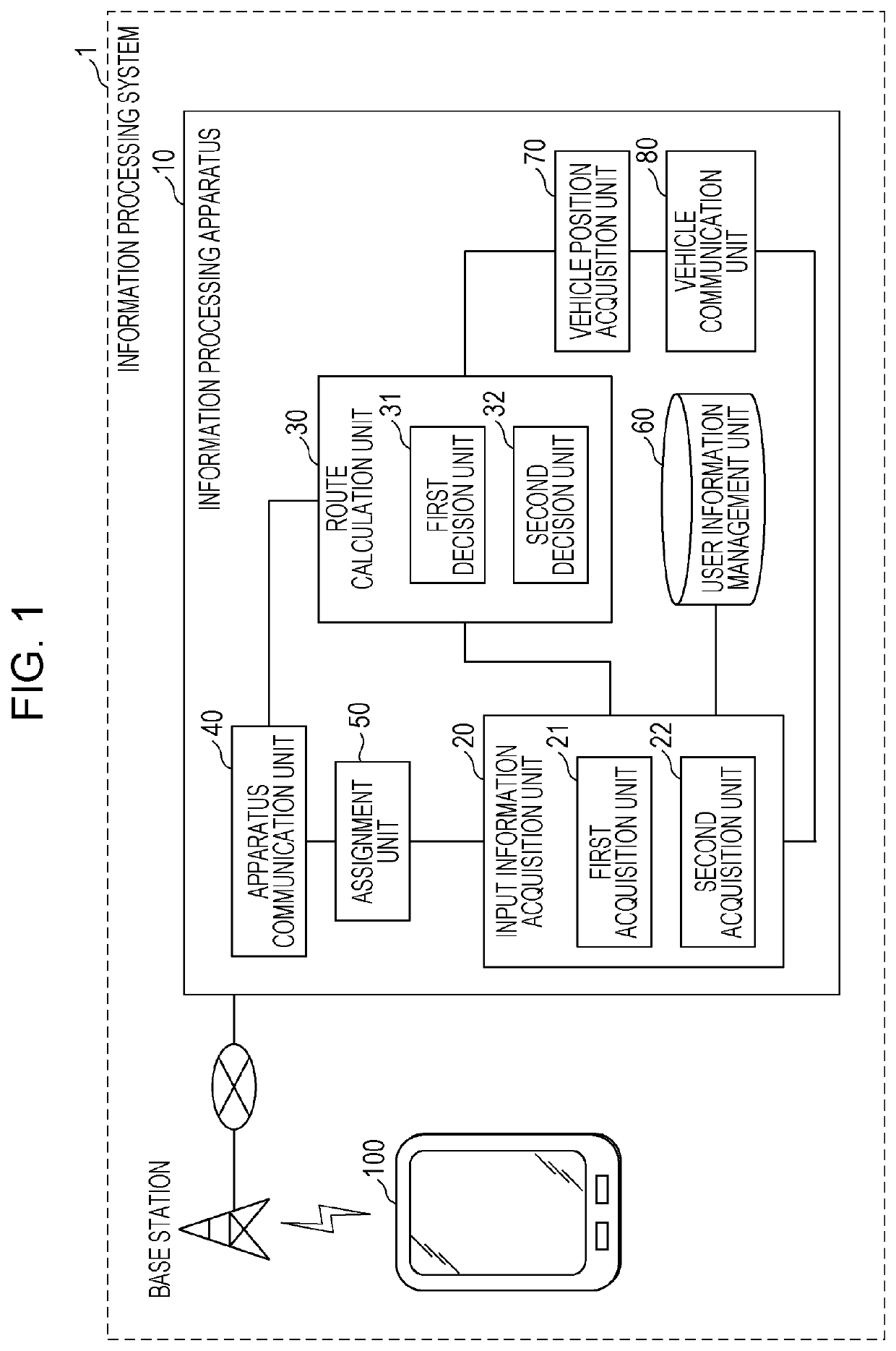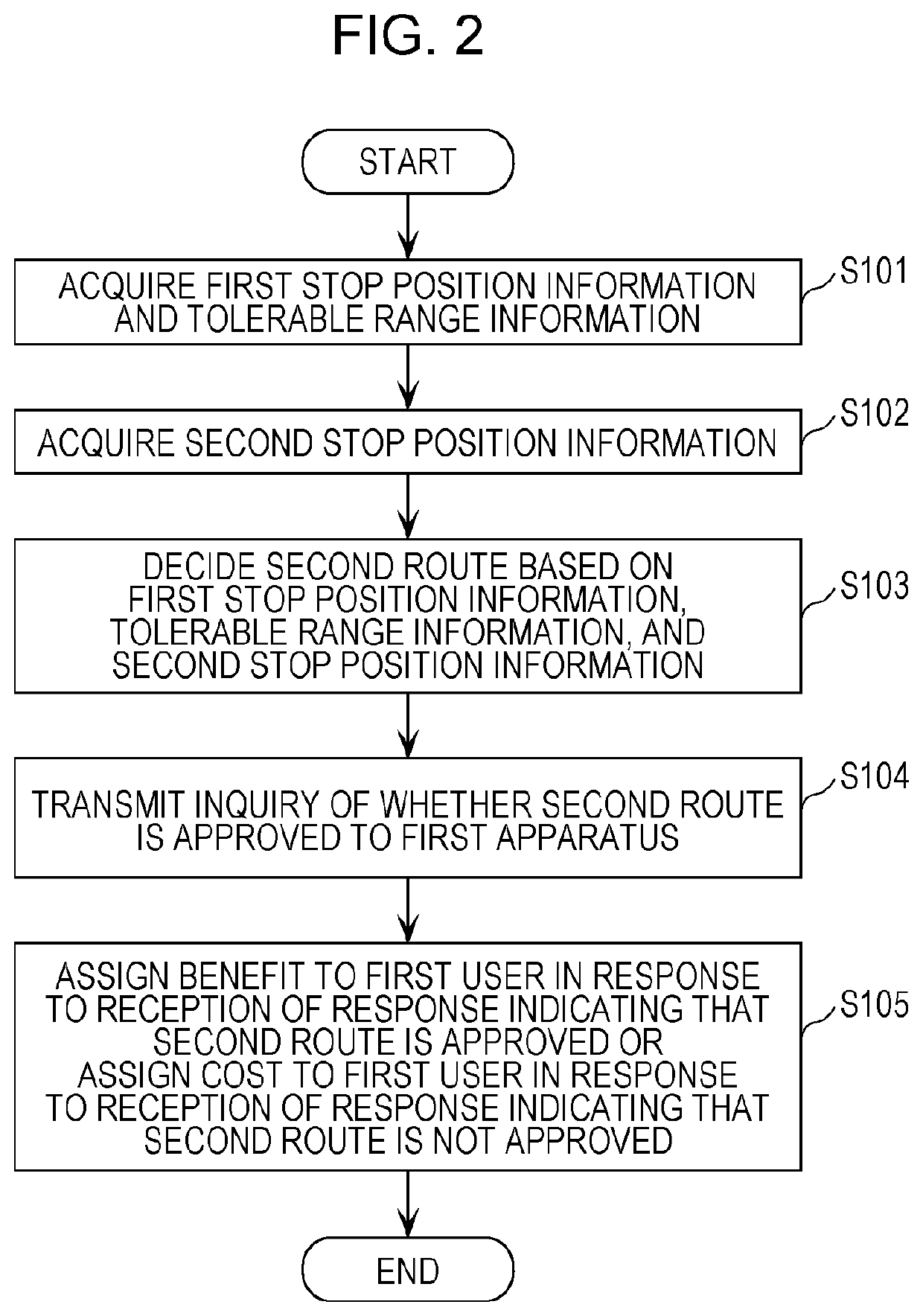Information processing method, information processing system, and recording medium storing program
a technology of information processing and recording medium, applied in the field of information processing, can solve the problems of lowering profitability, energy consumption, running efficiency, etc., and achieve the effect of lowering running efficiency, increasing energy consumption, and lowering profitability for one vehicl
- Summary
- Abstract
- Description
- Claims
- Application Information
AI Technical Summary
Benefits of technology
Problems solved by technology
Method used
Image
Examples
embodiments
(Embodiments)
[0060]The embodiments will hereinafter be described with reference to FIG. 1 to FIG. 17.
[1. Configuration of Information Processing System]
[0061]FIG. 1 is a block diagram that illustrates one example of a configuration of an information processing system 1 according to an embodiment.
[0062]The information processing system 1 is a system for performing vehicle allocation of a passenger transportation vehicle (also referred to as vehicle) and it is possible that the information processing system 1 is applied to a shared taxi, a shared bus, and so forth, for example. Further, in the future, it is possible that the information processing system 1 will be applied to a shared taxi that uses an autonomous vehicle. The information processing system 1 includes an information processing apparatus 10 and a first apparatus 100.
[0063]The first apparatus 100 is a computer that includes a processor (microprocessor), a memory, a communication interface (a communication circuit or the li...
first embodiment
[2-1. First Embodiment]
[0077]A first embodiment will be described with reference to FIG. 3 to FIG. 11.
[0078]FIG. 3 is a flowchart that illustrates one example of an action of the information processing apparatus 10 in the first embodiment. A process from step S201 is started by reception of a request for vehicle allocation of the passenger transportation vehicle from the first user by the information processing apparatus 10, for example.
[0079]First, the vehicle position acquisition unit 70 acquires the present position of the vehicle (step S201).
[0080]Next, the first acquisition unit 21 acquires the first desired stop position (step S202). FIG. 4 is a diagram that illustrates one example of a first desired stop position A1 in the first embodiment. The first desired stop position A1 that is designated by the first user is indicated in FIG. 4. In this case, the first acquisition unit 21 acquires the range of the gap (also referred to as tolerable range) from the first desired stop pos...
second embodiment
[2-2. Second Embodiment]
[0120]Next, a second embodiment will be described with reference to FIG. 12 and FIG. 13. Note that in the second embodiment, a description will be made about an action of the information processing apparatus 10 at a time after the vehicle allocation request is made by the second user, the second route is then approved by the first user, and the riding or getting-off position of the first user is changed.
[0121]FIG. 12 is a flowchart that illustrates one example of the action of the information processing apparatus in the second embodiment. FIG. 13 is a diagram for explaining the second route in the second embodiment. FIG. 13 illustrates the first desired stop position A1, a second desired stop position B1a, a second route R5 in which the vehicle passes a region within the tolerable range of the first user and reaches the second desired stop position B1a, and a stop position A2 on the second route R5, which results from a change by the first user. Further, the ...
PUM
 Login to View More
Login to View More Abstract
Description
Claims
Application Information
 Login to View More
Login to View More - R&D
- Intellectual Property
- Life Sciences
- Materials
- Tech Scout
- Unparalleled Data Quality
- Higher Quality Content
- 60% Fewer Hallucinations
Browse by: Latest US Patents, China's latest patents, Technical Efficacy Thesaurus, Application Domain, Technology Topic, Popular Technical Reports.
© 2025 PatSnap. All rights reserved.Legal|Privacy policy|Modern Slavery Act Transparency Statement|Sitemap|About US| Contact US: help@patsnap.com



